New Spoke Tools
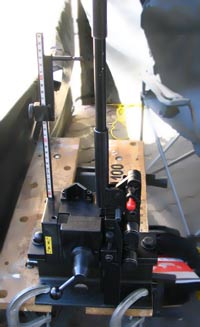 We met up with Ric Hjertberg of Wheelsmith fame while working at the Cranksworx Gravity Fest in Whistler. Between manning booths and wrenching on downhill bikes he showed us some new spoke tools that he’s been working on with the support of FSA. Both will most likely be on display at Interbike and it sounds like they may be ready for sales by the end of the year.
We met up with Ric Hjertberg of Wheelsmith fame while working at the Cranksworx Gravity Fest in Whistler. Between manning booths and wrenching on downhill bikes he showed us some new spoke tools that he’s been working on with the support of FSA. Both will most likely be on display at Interbike and it sounds like they may be ready for sales by the end of the year.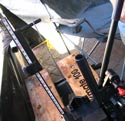 The first is a very easy to use spoke cutter that mounts to most table tops and, due to its ability to be taken apart, is fairly transportable. The first thing he showed us was cutting of the spoke’s length. This device uses gravity to hold the spoke while you pull up the arm to the desired length. A lever is then pulled down to cut the spoke. Besides ease of use this tool did not flair the end of the spoke as can be common with some other cutters.
The first is a very easy to use spoke cutter that mounts to most table tops and, due to its ability to be taken apart, is fairly transportable. The first thing he showed us was cutting of the spoke’s length. This device uses gravity to hold the spoke while you pull up the arm to the desired length. A lever is then pulled down to cut the spoke. Besides ease of use this tool did not flair the end of the spoke as can be common with some other cutters.
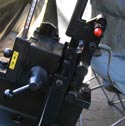 The spoke is then removed from the upper arm and placed into the side of the device while the lever is removed from its previous place and set into another mounting hole.
The spoke is then removed from the upper arm and placed into the side of the device while the lever is removed from its previous place and set into another mounting hole. 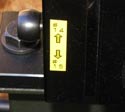 By pulling down on the lever you pull the spoke up through the device and out the top, rolling threads the whole way. The cutter also provides a simpler button lever on the opposite side to choose between 14 and 15 guage spokes to make sure the threads are done correctly.
By pulling down on the lever you pull the spoke up through the device and out the top, rolling threads the whole way. The cutter also provides a simpler button lever on the opposite side to choose between 14 and 15 guage spokes to make sure the threads are done correctly.
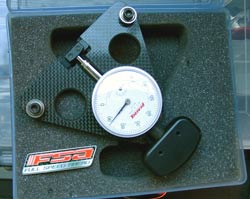 If you’ve chatted with Ric Hjertberg over the past few years you may have heard some discussion about a Jobst Brandt design for a spoke guage (tensionometer). The idea includes precision ball bearings for low drag and extra low spring force for higher accuracy. Plus, it would include the capability of adjusting its starting position so that the size of the spoke doesn’t affect the beginning of the measurement. Yes, on current spoke tensionometers,
If you’ve chatted with Ric Hjertberg over the past few years you may have heard some discussion about a Jobst Brandt design for a spoke guage (tensionometer). The idea includes precision ball bearings for low drag and extra low spring force for higher accuracy. Plus, it would include the capability of adjusting its starting position so that the size of the spoke doesn’t affect the beginning of the measurement. Yes, on current spoke tensionometers, 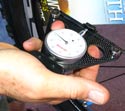 including the Wheelsmith model, the size of the spoke can actually cause some deflection and thereby affect the true tension reading. Its design also uses a dial rather than printed numbers on the device for more accuracy.
including the Wheelsmith model, the size of the spoke can actually cause some deflection and thereby affect the true tension reading. Its design also uses a dial rather than printed numbers on the device for more accuracy.
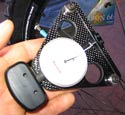 He’s been working with this design for a while and was showing a carbon version over the weekend. Its very lightweight and simple to use. The guage is placed in the users palm and two fingers pull the unit against the palm. This causes the center portion to open up so that spokes can more easily be placed between the bearings and the dial guage pin. You then set the zero position and release the power in your fingers. This then provides a reading on the dial which is compared to a chart showing the corresponding tension. This tool will be more expensive then the tensionometers from Wheelsmith and Park Tool but is more accurate and is aimed at a price lower than that of DT.
He’s been working with this design for a while and was showing a carbon version over the weekend. Its very lightweight and simple to use. The guage is placed in the users palm and two fingers pull the unit against the palm. This causes the center portion to open up so that spokes can more easily be placed between the bearings and the dial guage pin. You then set the zero position and release the power in your fingers. This then provides a reading on the dial which is compared to a chart showing the corresponding tension. This tool will be more expensive then the tensionometers from Wheelsmith and Park Tool but is more accurate and is aimed at a price lower than that of DT.
